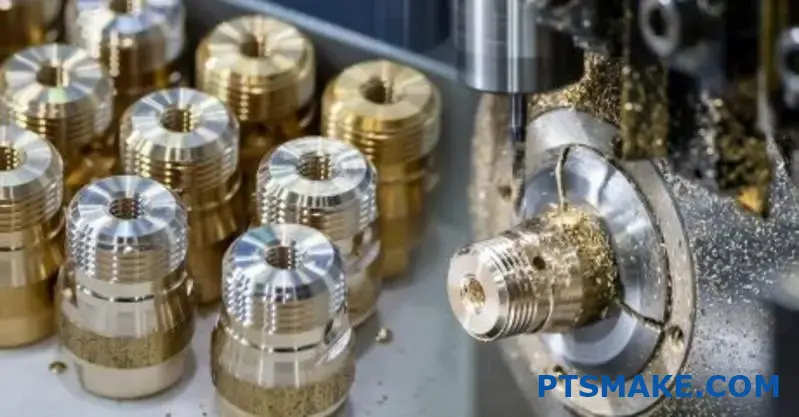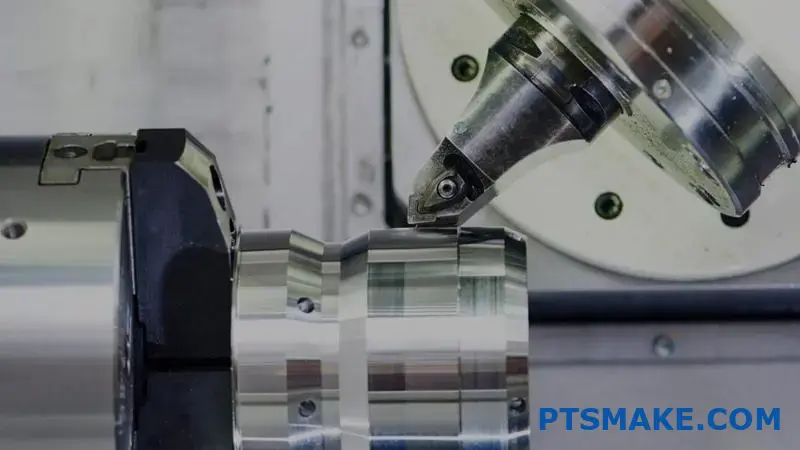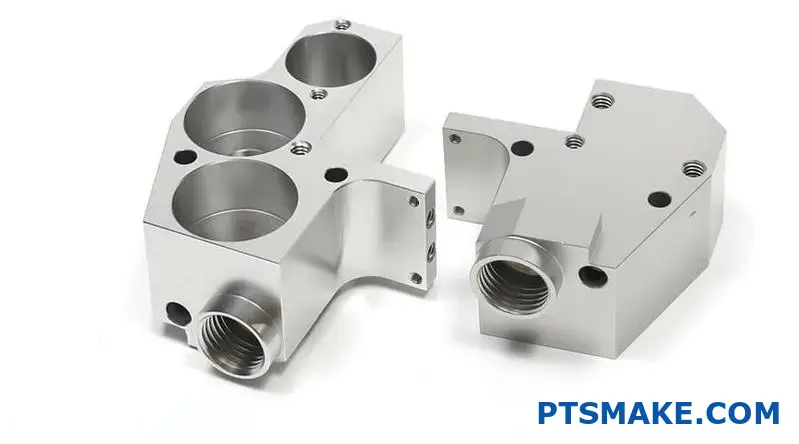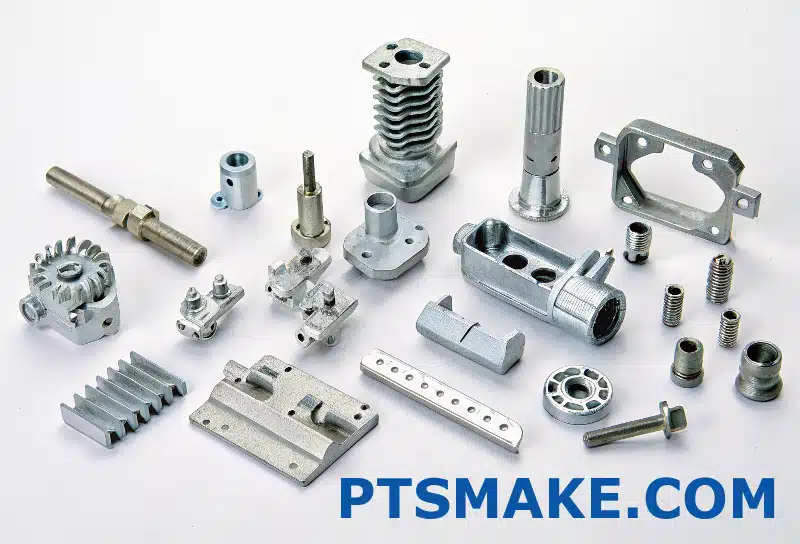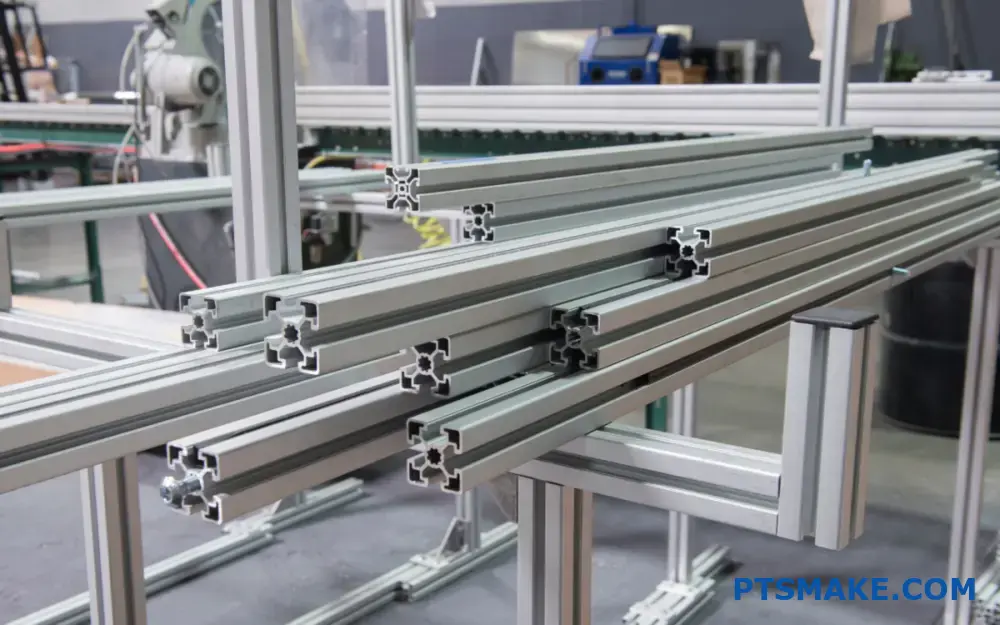Have you ever struggled with choosing the right hinge for your project? It’s frustrating when doors or panels don’t align properly or move smoothly. The wrong hinge choice can lead to functionality issues and premature wear, costing you time and money.
The three main types of hinges are butt hinges, concealed hinges, and continuous hinges. Butt hinges are visible when the door is closed, concealed hinges are hidden, and continuous hinges run the full length of the door for maximum support.

Understanding these hinge varieties is just the beginning. Each type has specific applications and advantages that can make or break your project. In my years at PTSMAKE, I’ve seen how the right hinge choice can transform functionality and aesthetics. Let me walk you through the details of each type so you can make the best decision for your specific needs.
What Are Z Hinges Used For?
Have you ever struggled with limited space when designing a cabinet or folding furniture? Or found yourself frustrated when a door doesn’t close properly because the hinge placement is awkward? These challenging spatial constraints can turn an otherwise perfect design into a functional nightmare.
Z hinges are specialized hardware components used primarily in cabinetry, furniture, and architectural applications where conventional hinges aren’t suitable. They allow doors to swing clear of the frame while maintaining proper alignment, making them ideal for flush-mounted doors and space-constrained installations.
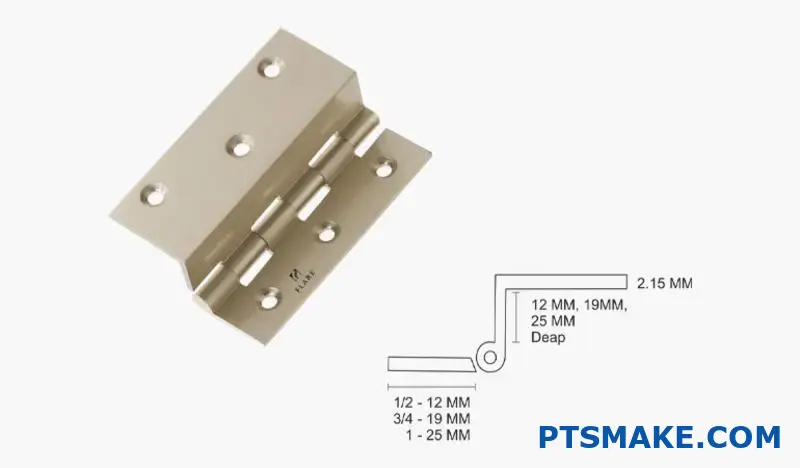
Understanding Z Hinges and Their Unique Design
Z hinges get their name from their distinctive Z-shaped design when viewed from above. Unlike standard hinges that operate on a single pivot point, Z hinges incorporate multiple bends or offsets that create a more complex movement path. This unique configuration gives them distinct advantages in specific applications.
In my experience working with various hinge mechanisms, Z hinges stand out for their versatility in solving difficult door placement problems. The Z-shaped design allows the hinge to create an offset when the door opens, which means the door can clear obstructions that would otherwise prevent it from opening fully.
Anatomy of a Z Hinge
Understanding the basic structure of a Z hinge helps explain its functionality:
- Mounting Leaf: The portion attached to the frame or cabinet body
- Door Leaf: The portion attached to the door or moving panel
- Offset Section: The distinctive Z-shaped bend that creates the clearance
- Pivot Points: The locations where the hinge allows rotational movement
The precise angles and dimensions of these components vary depending on the specific application requirements. Most Z hinges are made from durable materials like steel, brass, or stainless steel to ensure they can withstand repeated use without failing.
Types of Z Hinges
Through my work at PTSMAKE, I’ve encountered several variations of Z hinges designed for different applications:
Standard Z Hinges
These feature a simple Z-shaped design and are commonly used in basic cabinetry applications.
Adjustable Z Hinges
These include mechanisms for fine-tuning the door position after installation, allowing for perfect alignment.
Heavy-Duty Z Hinges
Reinforced versions designed for larger doors or applications with frequent use.
Concealed Z Hinges
These are designed to remain hidden when the door is closed, providing a cleaner aesthetic.
Each type has its own set of specifications and optimal applications, which I’ll explore in more detail below.
Primary Applications of Z Hinges
Z hinges excel in several specific scenarios where traditional hinges would create functional problems. Let’s examine where they prove most valuable:
Flush-Mount Doors in Cabinetry
One of the most common applications for Z hinges is in flush-mounted1 cabinets. When a door needs to sit completely flush with the surrounding frame when closed, but must swing clear of that frame when opened, a Z hinge provides the perfect solution.
The offset design allows the door to first move outward before swinging to the side, clearing the frame entirely. This creates a clean aesthetic when closed while maintaining full functionality when open.
Space-Restricted Environments
In tight spaces where door clearance is limited, Z hinges offer a practical solution. By altering the swing path of the door, they can:
- Allow doors to open in tight corners
- Prevent doors from hitting nearby walls or fixtures
- Enable full access in constricted spaces
I’ve implemented Z hinges in multiple projects where architectural constraints would have otherwise prevented doors from opening properly. The carefully calculated offset can make all the difference in these challenging installations.
Specialty Furniture Applications
Many specialty furniture pieces benefit from Z hinges:
- Fold-Down Desks: The Z hinge allows the desktop to tuck neatly against the wall when not in use
- Murphy Beds: Some designs use Z hinges to manage the complex folding mechanism
- Transforming Furniture: Pieces that change configuration often rely on specialized hinges including Z variants
Automotive and Transportation Uses
Beyond furniture and cabinetry, Z hinges find applications in:
- RV and Marine Storage: Space-efficient compartments often rely on Z hinges
- Commercial Vehicle Compartments: Service vehicles with specialized storage systems
- Aircraft Interior Components: Where precise movement paths are essential
Technical Considerations When Selecting Z Hinges
Choosing the right Z hinge for a specific application requires careful consideration of several factors:
Load Capacity and Material Selection
The weight of the door directly impacts the required strength of the Z hinge. This table outlines general guidelines based on my manufacturing experience:
| Door Weight | Recommended Z Hinge Material | Minimum Thickness |
|---|---|---|
| Light (<5 lbs) | Steel, Brass | 1.5mm |
| Medium (5-15 lbs) | Stainless Steel, Heavy Brass | 2.0mm |
| Heavy (>15 lbs) | Heavy-Duty Steel, Reinforced | 3.0mm+ |
Multiple hinges may be required for heavier applications, typically spaced evenly along the door edge.
Clearance Requirements
Proper function of a Z hinge depends on providing adequate clearance for its movement. When designing around Z hinges, I always ensure:
- Sufficient space for the full range of motion
- Clearance from obstructions throughout the opening arc
- Appropriate gap dimensions between the door and frame
Failure to account for these clearance requirements can result in binding, damaged finishes, or improper door function.
Mounting Considerations
The mounting method significantly impacts the performance and longevity of Z hinges:
- Screw Type and Size: Must be appropriate for both the hinge and the substrate
- Mounting Surface Preparation: Ensuring surfaces are flat and properly reinforced if needed
- Alignment Tools: Using templates or jigs to guarantee precise placement
- Number of Fasteners: Following manufacturer recommendations for secure attachment
In my manufacturing work, I’ve found that proper mounting is often the difference between a smoothly functioning installation and one plagued with alignment issues.
Comparing Z Hinges to Alternative Hinge Types
To fully appreciate when Z hinges are the right choice, it’s helpful to compare them to other common hinge types:
Z Hinges vs. Butt Hinges
Traditional butt hinges offer simple functionality but limited versatility:
- Butt Hinges: Create a simple pivot point with the door edge aligned with the hinge axis
- Z Hinges: Create an offset pivot that allows the door to clear the frame
While butt hinges work well for standard doors with frame clearance, they cannot accommodate flush mounting or tight spaces as effectively as Z hinges.
Z Hinges vs. Piano Hinges
Piano hinges (continuous hinges) provide different benefits:
- Piano Hinges: Distribute weight evenly along the entire door edge
- Z Hinges: Create specific movement paths to solve clearance problems
Each serves a different purpose, with piano hinges excelling in distributing load while Z hinges excel in creating specialized movement paths.
Z Hinges vs. European Concealed Hinges
Modern European-style concealed cabinet hinges have become incredibly popular:
- European Hinges: Completely hidden when closed, offering adjustability in multiple directions
- Z Hinges: Visible but provide specific offset movement that some European hinges cannot match
European hinges have largely replaced Z hinges in many standard cabinetry applications, but Z hinges still excel in specialized scenarios where the particular movement path is required.
Installation Best Practices for Z Hinges
Through my years designing manufacturing solutions, I’ve developed some key installation practices that ensure optimal Z hinge performance:
Precise Measurement and Marking
Successful Z hinge installation begins with accurate layout:
- Determine ideal hinge locations based on door size and weight
- Mark precise positions using measuring tools and templates
- Verify clearances will be maintained throughout the door’s movement
- Double-check all measurements before making any cuts or drilling holes
Proper Tools and Techniques
Using the right tools makes a significant difference:
- Sharp Drill Bits: For clean, precise mounting holes
- Appropriate Screwdrivers: To prevent damage to screw heads
- Specialized Jigs: For consistent hinge mortising when required
- Calipers or Precision Rules: For verifying critical dimensions
Testing and Adjustment
After installation, thorough testing helps identify any needed adjustments:
- Open and close the door through its full range of motion
- Check for binding or interference at any point
- Verify the door aligns properly when closed
- Make fine adjustments to mounting or add shims if necessary
Maintenance Considerations
Z hinges, like all mechanical components, benefit from proper maintenance:
- Periodic lubrication of moving parts
- Checking and tightening fasteners as needed
- Cleaning accumulated debris that might interfere with movement
- Inspecting for wear and replacing before failure occurs
Common Challenges and Solutions with Z Hinges
Even with careful selection and installation, certain challenges can arise with Z hinges:
Alignment Issues
Problem: Door doesn’t align properly when closed.
Solution: Add thin shims behind hinge leaves or adjust mounting position.
Binding During Operation
Problem: Door binds or sticks at certain points in its travel.
Solution: Check for and remove obstructions, verify proper clearances, or consider a different hinge variant with more appropriate offset dimensions.
Weight-Related Failures
Problem: Hinges sag or fail to support the door properly.
Solution: Upgrade to heavier-duty hinges, add additional hinges, or reinforce mounting areas.
What Are The Disadvantages Of Brass Hinges?
Have you ever installed beautiful brass hinges on a door or cabinet, only to find them tarnishing or failing prematurely? Or wondered why your brass hinges constantly need maintenance despite their elegant appearance? This common frustration has left many project managers and engineers questioning their material choices.
Brass hinges, while aesthetically pleasing with their golden appearance, come with significant drawbacks including susceptibility to corrosion, lower strength compared to steel alternatives, higher cost, maintenance requirements, and potential for galvanic corrosion when paired with incompatible metals.
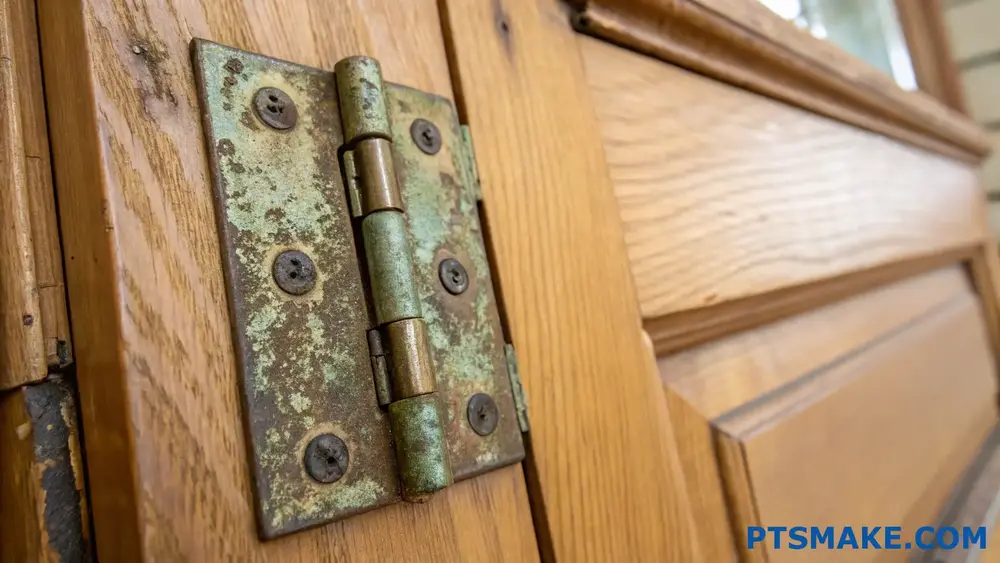
Corrosion and Tarnishing Issues
Natural Tarnishing Process
One of the most significant disadvantages of brass hinges is their natural tendency to tarnish over time. This occurs because brass is an alloy primarily composed of copper and zinc. When exposed to air and moisture, brass undergoes oxidation, resulting in a dull, darkened appearance that many find unattractive. In my experience working with various hardware components at PTSMAKE, I’ve observed that even high-quality brass hinges will eventually lose their lustrous gold appearance without proper maintenance.
The tarnishing process of brass hinges is actually a chemical reaction called oxidation2. While this process doesn’t immediately affect the structural integrity of the hinge, it does significantly impact the aesthetic appeal that draws many to choose brass in the first place. For projects where maintaining a consistent appearance is crucial, this natural degradation can be problematic.
Performance in Humid Environments
Brass hinges perform particularly poorly in humid or salt-air environments. Coastal homes, bathrooms, kitchens, and outdoor applications present challenging conditions for brass hardware. In these environments, the corrosion process accelerates considerably, leading to more rapid deterioration.
I recently advised a client who installed brass hinges in their beachfront property, only to find them developing a greenish patina (verdigris) within just a few months. This experience highlights why many seaside architects and builders now specifically avoid brass hardware despite its initial visual appeal.
Dezincification Concerns
A specific form of corrosion called dezincification can affect brass hinges with high zinc content. This process occurs when zinc leaches out of the brass alloy, leaving behind a weakened, porous copper structure. What makes this particularly problematic is that the hinge may maintain its shape while becoming structurally compromised.
Dezincification typically occurs in:
- Areas with hard water
- Marine environments
- Places with acidic atmospheric conditions
- Applications where the brass comes into contact with certain chemicals
Strength and Durability Limitations
Weight-Bearing Capacity
Compared to steel or stainless steel alternatives, brass hinges generally offer lower strength properties. This makes them less suitable for heavy-duty applications or situations requiring high load-bearing capacity. For example:
| Hinge Material | Approximate Tensile Strength | Recommended Applications |
|---|---|---|
| Brass | 310-550 MPa | Light doors, cabinets, decorative boxes |
| Stainless Steel | 500-850 MPa | Heavy doors, gates, industrial applications |
| Steel | 400-700 MPa | Medium to heavy doors, commercial uses |
| Bronze | 250-350 MPa | Decorative applications, marine environments |
When working on projects requiring durability under significant stress, I often steer clients away from brass hinges despite their aesthetic appeal. For heavy exterior doors or frequently used entryways, the material simply doesn’t provide the long-term performance needed.
Fatigue Resistance
Brass hinges also exhibit lower fatigue resistance compared to steel varieties. After repeated movements, brass may develop stress cracks or wear more quickly at pivot points. This is particularly problematic in high-traffic applications like commercial doors or frequently accessed cabinets.
The mechanical properties of brass make it more susceptible to deformation under repeated stress. Over my years in manufacturing, I’ve seen numerous cases where brass hinges begin to sag or develop play at the pin after just a few years of regular use, whereas comparable steel hinges maintain their precision much longer.
Temperature Effects
Another limitation of brass hinges is their behavior across temperature ranges. Brass expands and contracts more readily with temperature changes compared to many alternative materials. This property can cause several issues:
- Seasonal sticking or binding as dimensions change
- Increased wear at contact points due to thermal expansion
- Potential loosening of mounting screws as the material cycles through temperature changes
These effects are particularly noticeable in outdoor applications or unregulated environments where temperature fluctuations are significant.
Cost Considerations
Initial Investment
Brass hinges typically command a premium price compared to steel or even some stainless steel options. The raw material cost of brass is higher, and the manufacturing process often requires additional steps to achieve the desired finish. For projects with tight budget constraints or where large numbers of hinges are required, this cost difference can be substantial.
Let me share a recent example: For a large-scale commercial project requiring 200 door hinges, the cost difference between brass and standard steel options came to nearly $3,000. This substantial price differential forced the client to reconsider their material selection, ultimately choosing steel hinges with a brass finish as a compromise.
Lifetime Expense
Beyond the initial purchase price, brass hinges incur ongoing maintenance costs that many fail to consider during the specification phase. These lifetime expenses include:
- Cleaning supplies and polishes specific to brass
- Protective coatings and lacquers that need periodic reapplication
- Potential replacement costs if the hinges fail prematurely
- Labor costs associated with regular maintenance
When evaluating the total cost of ownership, these ongoing expenses often make brass hinges significantly more expensive than alternatives that may have a higher upfront cost but require minimal maintenance, such as certain grades of stainless steel.
Maintenance Requirements
Regular Cleaning Needs
Maintaining the appearance of brass hinges requires consistent effort. Regular cleaning is necessary to prevent tarnish buildup, typically using:
- Specialized brass cleaners or polishes
- Natural solutions like vinegar and salt mixtures
- Commercial metal polishing compounds
This maintenance isn’t simply cosmetic—allowing corrosion to progress can eventually impact the functionality of the hinge. At PTSMAKE, we often advise clients that if they’re unwilling to commit to a regular maintenance schedule, brass may not be the appropriate choice for their application.
Protective Coating Limitations
Many brass hinges come with factory-applied protective lacquers or coatings designed to prevent tarnishing. However, these coatings have significant limitations:
- They eventually wear off, especially at contact points
- Some cleaners or chemicals can damage the protective layer
- Once compromised, the protective coating often needs complete removal and reapplication
- The coating can yellow over time, affecting the appearance
I’ve found that even the highest quality protective coatings typically last only 1-3 years before requiring attention, making this an ongoing maintenance consideration rather than a one-time solution.
Repair Complexity
When brass hinges fail or become damaged, repairs are often more complex than with other materials. Brass is more difficult to weld properly than steel, and repairs frequently require specialized skills. Additionally, replacement parts may need to be custom-fabricated to match existing components, especially for decorative or antique-style hardware.
Compatibility Issues
Galvanic Corrosion Risk
One of the most serious technical concerns with brass hinges is their potential to cause galvanic corrosion when in contact with certain other metals. When dissimilar metals come into contact in the presence of an electrolyte (even just humidity in the air), an electrochemical reaction can occur that accelerates corrosion.
This is particularly problematic when brass hinges are used with:
- Aluminum components
- Certain grades of steel
- Some zinc-plated hardware
In architectural applications where multiple metal types are used, this incompatibility can lead to premature failure not just of the hinge itself, but potentially of the surrounding materials.
Mounting Hardware Concerns
Brass hinges ideally require brass screws for mounting to prevent galvanic reactions. However, brass screws are generally softer and more prone to stripping during installation than steel screws. This creates a practical dilemma:
- Use matching brass screws and risk installation difficulties
- Use stronger steel screws and potentially create galvanic corrosion issues
This compatibility challenge has caused significant problems in many projects, especially when less experienced installers attempt to substitute hardware based on what’s readily available.
Environmental Considerations
Manufacturing Impact
The production of brass hinges carries a larger environmental footprint compared to some alternatives. Brass manufacturing involves:
- Energy-intensive mining and processing of copper and zinc
- Chemical treatments for finishing and coating
- Often higher waste production during manufacturing
For environmentally conscious projects, these factors may influence material selection decisions. At PTSMAKE, we’ve noticed increasing client interest in the full lifecycle environmental impact of components like hinges, not just their functional properties.
End-of-Life Recyclability
While brass is technically recyclable, hinges often incorporate other materials like steel pins or decorative elements that complicate the recycling process. Additionally, the protective coatings and treatments applied to maintain appearance can introduce contaminants into the recycling stream.
Aesthetic Limitations
Design Consistency Challenges
Despite their initial beauty, brass hinges create unique challenges for maintaining design consistency over time. As different areas receive varying levels of use, exposure, and maintenance, brass components can develop uneven patination and appearance. This is particularly noticeable in large installations where some hinges might look significantly different than others after just a few years.
In one commercial project I consulted on, the brass hinges on the main entrance doors developed a completely different appearance than the same model hinges used on less-frequently accessed doors within just two years. This inconsistency created an unintended haphazard aesthetic that undermined the original design intent.
Limited Color Options
While brass is prized for its warm golden tone, this very specificity can be limiting in design schemes. Unlike steel hinges, which can be easily plated or painted in virtually any color, brass hinges
What Are Hinge Grades?
Have you ever installed a hinge only to find it failing under regular use? Or spent too much time trying to figure out why some hinges outperform others in seemingly similar applications? The difference often lies in something many engineers and designers overlook – the hinge grade.
Hinge grades are standardized quality classifications that indicate a hinge’s durability, load capacity, and appropriate applications. These grades, established by ANSI/BHMA standards, range from Grade 1 (highest quality) to Grade 3 (basic quality) and help determine which hinge is suitable for specific usage conditions and environments.
Understanding the Hinge Grade System
In my experience working with various manufacturing projects, I’ve found that hinge grade selection can make or break a product’s functionality. The standardized grading system gives us a reliable framework to select the right component for each application.
The ANSI/BHMA Standards
The American National Standards Institute (ANSI) and the Builders Hardware Manufacturers Association (BHMA) have developed a comprehensive classification system for hinges. This system categorizes hinges into three primary grades:
- Grade 1: Commercial/Heavy-duty
- Grade 2: Light Commercial
- Grade 3: Residential/Light-duty
These grades are determined through rigorous testing procedures that evaluate factors like:
- Cycle testing (opening and closing durability)
- Weight capacity
- Vertical and horizontal stress resistance
- Finish durability
- Material quality
Grade 1 Hinges: Commercial and Heavy-Duty Applications
Grade 1 hinges represent the highest quality standard in the industry. These hinges are designed to withstand extreme conditions and heavy usage patterns typically found in commercial settings.
When we manufacture Grade 1 hinges at PTSMAKE, they undergo testing for at least 1 million cycles. This might sound excessive, but in high-traffic commercial environments like hospitals or schools, doors might be opened and closed hundreds of times daily.
Characteristics of Grade 1 hinges include:
- Constructed from high-grade materials (typically solid brass, stainless steel, or bronze)
- Thicker, more substantial gauge metal
- Reinforced mounting points
- Premium ball or roller bearings
- Enhanced corrosion resistance
- Higher weight capacity (typically 400-600 pounds)
These hinges are ideal for:
- High-traffic commercial buildings
- Heavy exterior doors
- Emergency exits
- Hospital or institutional settings
- Industrial equipment
- Military applications
Grade 2 Hinges: Light Commercial Applications
Grade 2 hinges occupy the middle ground between heavy-duty commercial and basic residential applications. I often recommend these for light commercial settings or high-end residential projects where durability matters but Grade 1 would be overkill.
These hinges typically undergo testing for approximately 500,000 cycles, making them suitable for moderate-use scenarios.
Characteristics of Grade 2 hinges include:
- Medium-gauge metal construction
- Good quality bearings
- Moderate corrosion resistance
- Weight capacity of approximately 200-300 pounds
Ideal applications include:
- Office buildings
- Apartment complexes
- Light commercial settings
- High-end residential doors
- Interior commercial doors
- Educational facilities with moderate traffic
Grade 3 Hinges: Residential Applications
Grade 3 hinges are designed for basic residential use and are tested for approximately 350,000 cycles. While this is the lowest ANSI/BHMA grade, it’s important to understand that these hinges are still manufactured to meet established standards.
Characteristics of Grade 3 hinges:
- Lighter gauge metal
- Basic bearing systems
- Standard finish options
- Weight capacity of approximately 100-180 pounds
These hinges are suitable for:
- Standard interior residential doors
- Light-duty closets
- Cabinet doors
- Storage areas
- Low-traffic residential applications
Factors That Determine Hinge Grades
Several key elements are evaluated during the grading process. Understanding these can help you make better selections for your specific application.
Material Composition
The material used in manufacturing hinges significantly impacts their grade:
| Material | Typical Grades | Characteristics | Best Applications |
|---|---|---|---|
| Stainless Steel | Grade 1, Grade 2 | High corrosion resistance, durability, strength | Exterior doors, humid environments, coastal areas |
| Solid Brass | Grade 1, Grade 2 | Excellent durability, aesthetic appeal, corrosion resistant | High-end commercial, luxury residential |
| Steel | Grade 2, Grade 3 | Good strength, economical, various finishes available | Interior doors, standard applications |
| Bronze | Grade 1, Grade 2 | Decorative, durable, natural patina development | Historic buildings, decorative applications |
| Aluminum | Grade 2, Grade 3 | Lightweight, corrosion resistant, economical | Light-duty applications, modern designs |
Bearing Technology
The bearing system used in a hinge dramatically affects its performance and grade classification:
Plain Bearing: Simple design with no additional components between the knuckles. These are typically found in Grade 3 hinges for basic residential applications.
Ball Bearing: Contains ball bearings between the knuckles to reduce friction and extend lifespan. Ball bearing hinges are commonly found in Grade 1 and Grade 2 classifications.
Olive Knuckle: Features an olive-shaped projection that rotates within a socket, providing smooth operation. These are often found in higher-grade decorative hinges.
Anti-friction Bearing: Incorporates specialized bearing materials to reduce friction without using ball bearings. These are common in Grade 2 applications.
Cycle Testing
One of the most critical factors in determining a hinge’s grade is cycle testing. This involves repeatedly opening and closing the hinge to simulate years of use:
- Grade 1: Minimum 1,000,000 cycles
- Grade 2: Minimum 500,000 cycles
- Grade 3: Minimum 350,000 cycles
At PTSMAKE, I’ve observed that proper cycle testing reveals issues that might not be apparent in initial inspections. It’s fascinating to see how seemingly minor design differences can lead to dramatically different long-term performance.
Load Capacity
Weight support is another crucial grading factor:
- Grade 1 hinges typically support 400-600 pounds
- Grade 2 hinges support approximately 200-300 pounds
- Grade 3 hinges support approximately 100-180 pounds
It’s worth noting that these capacities assume proper installation and distribution across multiple hinges. Using too few hinges for a heavy door is a common mistake I see in many projects.
Specialized Hinge Grades for Specific Applications
Beyond the standard ANSI/BHMA grades, specialized classifications exist for particular applications.
Fire-Rated Hinges
Fire-rated hinges must comply with additional standards beyond the regular grading system. These hinges are crucial components in fire-rated door assemblies and undergo testing for:
- Heat resistance
- Structural integrity during fire conditions
- Self-closing functionality
- Alignment maintenance during thermal expansion
Fire-rated hinges generally fall into the Grade 1 category but must also meet UL (Underwriters Laboratories) standards and local building codes. The standard test involves subjecting the hinge to temperatures exceeding 1,700°F to ensure it maintains functionality.
Security Hinges
Security-grade hinges incorporate additional features to prevent unauthorized access:
- Non-removable Pins (NRP): Prevent the hinge pin from being removed when the door is closed
- Hospital Tips: Sloped knuckles that prevent items from being hung on the hinge
- Security Studs: Projections that interlock when the door is closed
- Concealed Hinges: Hidden from view when the door is closed
These security features are available across different grades, though they’re most commonly found in Grade 1 and Grade 2 hinges.
Electrified Hinges
With the growth of smart building technology, electrified hinges have become increasingly important. These specialized hinges contain concealed wiring channels to transfer power and data from the frame to the door without exposed wires.
Electrified hinges typically fall into Grade 1 or Grade 2 classifications but must also meet electrical standards and offer:
- Adequate current capacity
- Wire protection
- Continuous electrical connection
- Compatibility with access control systems
How to Select the Right Hinge Grade for Your Project
Choosing the appropriate hinge grade requires consideration of several factors:
Usage Intensity
Evaluate how frequently the door will be used:
- High-frequency (100+ operations daily): Grade 1
- Medium-frequency (50-100 operations daily): Grade 2
- Low-frequency (fewer than 50 operations daily): Grade 3
Door Weight and Size
Heavier doors require higher-grade hinges:
- Heavy doors (over 200 pounds): Grade 1
- Medium-weight doors (100-200 pounds): Grade 2
- Light doors (under 100 pounds): Grade 3
Remember to calculate the total door weight including all hardware and accessories. For custom hinges, we at PTSMAKE always recommend factoring in a safety margin of at least 25% above the expected load.
Environmental Conditions
Consider the environment where the hinge will operate:
- Exterior doors exposed to elements: Grade 1 with appropriate finish
- Humid environments (bathrooms, pool areas): Grade 1 or 2 with corrosion-resistant materials
- Standard interior environments: Grade 2 or 3 depending on usage
- Corrosive environments: Grade 1 with specialized materials (316 stainless steel)
Budget Constraints
While Grade 1 hinges offer superior performance, they come at a higher price point:
- Grade 1: Highest cost, but lowest lifetime cost due to durability
- Grade 2: Moderate initial cost, good value for appropriate applications
- Grade 3: Lowest initial cost, suitable for basic applications
In my experience, investing in higher-grade hinges for critical applications pays dividends through reduced maintenance and replacement costs
Selecting the Right Material Based on Application Requirements?
Have you ever spent hours designing the perfect product, only to have it fail because you chose the wrong hinge material? Or perhaps you’ve watched your production costs spiral when an expensive hinge material was specified where a more economical option would have performed just as well?
Selecting the right material for custom hinges depends primarily on the specific application requirements, including environmental conditions, load capacity, durability needs, and cost constraints. The ideal material balances mechanical properties, corrosion resistance, and economic considerations for your particular use case.
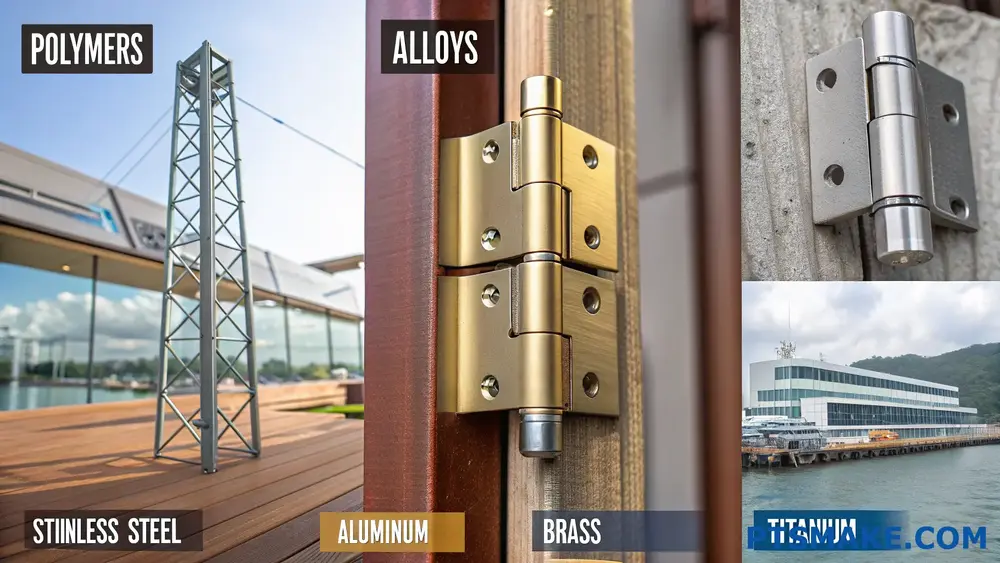
Matching Materials to Application Environments
When choosing materials for custom hinges, the operating environment is perhaps the most critical factor to consider. Different applications expose hinges to vastly different conditions, and selecting a material that can withstand these specific challenges is essential for long-term performance.
Indoor vs. Outdoor Applications
Indoor applications generally present less demanding conditions for hinges. For standard indoor use with minimal exposure to moisture or extreme temperatures, materials like brass, aluminum, or even certain polymers often provide sufficient performance at reasonable cost points.
However, outdoor applications introduce a whole new set of challenges. Hinges used outdoors must contend with:
- UV radiation
- Temperature fluctuations
- Precipitation
- Air pollutants
- Potential salt exposure (in coastal areas)
For these applications, materials with excellent corrosion resistance become essential. Stainless steel (particularly 316 grade), aluminum with anodized coating, or specialized weather-resistant polymers are common choices. I’ve seen numerous cases where clients initially selected standard steel hinges for outdoor applications, only to face premature failure and costly replacements within months.
Temperature Extremes
Temperature range is another crucial consideration that often gets overlooked during material selection. Some materials that perform admirably at room temperature may become brittle in cold environments or lose structural integrity in high heat.
For high-temperature environments (such as hinges used near engines, heating equipment, or industrial ovens), special high-temperature alloys are recommended:
- Inconel (nickel-chromium alloy) – Maintains strength at temperatures up to 1000°C
- High-grade stainless steel – Good performance up to 800°C
- Titanium alloys – Excellent strength-to-weight ratio at elevated temperatures
Conversely, for extreme cold environments, materials that maintain ductility at low temperatures are essential:
- Austenitic stainless steel (304, 316 grades)
- Special aluminum alloys
- Certain engineered polymers with low-temperature modifiers
Chemical Exposure Considerations
In environments where hinges may be exposed to chemicals, selecting a material with appropriate chemical resistance is critical. This is particularly important in:
- Industrial settings with chemical processing
- Medical environments with frequent sterilization
- Food processing facilities
- Marine applications (salt water exposure)
For chemical resistance, these materials often stand out:
- PTFE (polytetrafluoroethylene) coated hinges
- Hastelloy (for severe chemical environments)
- High-grade stainless steel (316 or higher)
- Certain engineering plastics like PEEK (polyetheretherketone3)
Mechanical Requirements and Load Considerations
Beyond environmental factors, the mechanical demands placed on the hinge must guide material selection. A hinge for a lightweight cabinet door has vastly different requirements than one for heavy industrial equipment.
Load-Bearing Capacity
The load a hinge must support directly influences material selection. For high-load applications, materials with excellent tensile strength and fatigue resistance are essential:
- Carbon steel (heat-treated for additional strength)
- Alloy steels
- Titanium alloys (when weight is also a concern)
- High-strength brass alloys
For medium to light loads, more options become viable:
- Aluminum alloys
- Standard brass
- Engineering polymers reinforced with fibers
- Zinc alloys
Here’s a simplified reference table for load-bearing capacity of common hinge materials:
| Material | Load Capacity | Best Applications |
|---|---|---|
| Carbon Steel | Very High | Heavy doors, gates, industrial equipment |
| Stainless Steel | High | Outdoor equipment, marine applications |
| Brass | Medium | Furniture, decorative applications |
| Aluminum | Medium | Light doors, electronic enclosures |
| Titanium | High | Aerospace, weight-sensitive high-load applications |
| Reinforced Polymers | Low to Medium | Electronic devices, light-duty applications |
Wear Resistance and Durability
Hinges that will undergo frequent operation require materials with excellent wear resistance. In my experience at PTSMAKE, clients often underestimate cycle counts when selecting materials, leading to premature failure.
For applications with high cycle counts, consider:
- Hardened steels with appropriate lubrication
- Bearing-grade bronze
- Self-lubricating polymers
- Stainless steel with hardened pins
For moderate use applications, standard grades of:
- Stainless steel
- Brass
- Aluminum
- Engineering polymers
Often provide adequate performance at reasonable cost points.
Friction and Movement Requirements
Some applications require specific friction characteristics. For example, certain door hinges need controlled resistance to prevent slamming, while others need minimal friction for smooth operation.
Materials and combinations that provide controlled friction:
- Brass on steel
- Bronze bushings with steel pins
- Certain polymer/metal combinations
For minimal friction applications:
- Stainless steel with PTFE coatings
- Self-lubricating polymers
- Bearing-grade materials
- Ball-bearing hinge designs
Economic Considerations in Material Selection
While performance is paramount, economic factors inevitably play a role in material selection. Finding the optimal balance between performance and cost often requires evaluating several factors:
Initial Material Costs
Raw material costs vary considerably among hinge materials:
- Carbon steel – Generally lowest cost
- Stainless steel – Moderate to high cost (varies by grade)
- Brass/bronze – Moderate to high cost
- Aluminum – Moderate cost
- Titanium – High cost
- Engineering polymers – Variable (some specialized formulations can be costly)
Manufacturing Process Compatibility
Different materials require different manufacturing processes, which can significantly impact overall costs. For instance, at PTSMAKE, we’ve helped clients reduce costs substantially by recommending materials that maintain required performance while allowing for more efficient manufacturing methods.
Material considerations for manufacturing efficiency:
- Machinability – Materials like free-cutting brass or certain aluminum alloys offer excellent machinability
- Formability – Some applications benefit from materials that can be cold-formed rather than machined
- Casting suitability – Zinc alloys excel in die-casting processes for complex hinge designs
Lifecycle Cost Analysis
Sometimes the most economical choice isn’t the cheapest initial option. When evaluating materials, consider:
- Expected service life in the application environment
- Maintenance requirements
- Replacement costs
- Downtime costs associated with failure
I’ve seen cases where investing in a premium material resulted in 5x longer service life, making it significantly more economical over the product lifecycle despite higher initial costs.
Special Considerations for Custom Hinges
Custom hinges often have unique requirements that standard off-the-shelf components don’t address. These special considerations can significantly influence material selection.
Aesthetic Requirements
When hinges are visible in the final product, aesthetic considerations may influence material choice:
- Brass and bronze offer warm, classic appearances
- Stainless steel provides a modern, clean look
- Anodized aluminum allows for color options
- Certain polymers can be color-matched to surrounding components
In architectural applications or high-end consumer products, these aesthetic considerations may justify premium material choices.
Weight Constraints
For applications where weight is critical (such as aerospace, portable electronics, or automotive components), lightweight materials become essential:
- Aluminum alloys (excellent strength-to-weight ratio)
- Titanium (superior strength-to-weight, though at higher cost)
- Engineering polymers (potentially reinforced with glass or carbon fiber)
- Magnesium alloys (though with corrosion resistance limitations)
Regulatory and Compliance Factors
Certain applications must meet specific regulatory requirements that impact material selection:
- Food-grade applications require materials that comply with FDA or similar regulations
- Medical devices may require biocompatible materials
- Aerospace applications have strict material certifications
- RoHS compliance restricts certain material compositions
These regulatory factors can significantly narrow the field of suitable materials for custom hinges.
Material Selection Decision Matrix
To systematically evaluate materials for custom hinges, consider using a decision matrix approach. Based on my experience at PTSMAKE, I’ve found this method helps clients make more objective material selections by quantifying the importance of different factors.
Here’s a simplified example of how such a matrix might look:
| Selection Criteria | Weight | Stainless Steel (316) | Aluminum (6061) | Brass | Engineering Polymer |
|---|---|---|---|---|---|
| Corrosion Resistance | 5 | 5 (25) | 3 (15) | 2 (10) | 5 (25) |
| Strength | 4 | 5 (20) | 3 (12) | 4 (16) | 2 (8) |
| Weight | 3 | 2 (6) | 4 (12) | 2 (6) | 5 (15) |
| Cost | 4 | 2 (8) | 4 (16) | 3 (12) | 4 (16) |
| Aesthetics | 2 | 4 (8) | 3 (6) | 5 (10) | 3 (6) |
| Total Score | 67 | 61 | 54 | 70 |
In this example, each factor is weighted by importance (1-5), and each material is rated on a scale of 1-5 for each factor. The weighted scores help identify the best overall material based on the specific application requirements.
Case Studies: Material Selection Success Stories
Over the years, I’ve encountered numerous situations where proper material selection made the difference between product
How to Choose the Right Custom Hinge for Your Project?
Have you ever spent hours searching for the perfect hinge, only to settle for a standard option that wasn’t quite right? Or worse, have you installed a stock hinge only to find it fails prematurely because it wasn’t designed for your specific application? These compromises can lead to product failures, customer complaints, and costly redesigns.
Choosing the right custom hinge involves evaluating your application requirements, material selection, load capacity needs, environmental factors, and dimensional constraints. Custom hinges offer tailored solutions that standard hinges simply cannot match, ensuring optimal performance and longevity for your specific project.
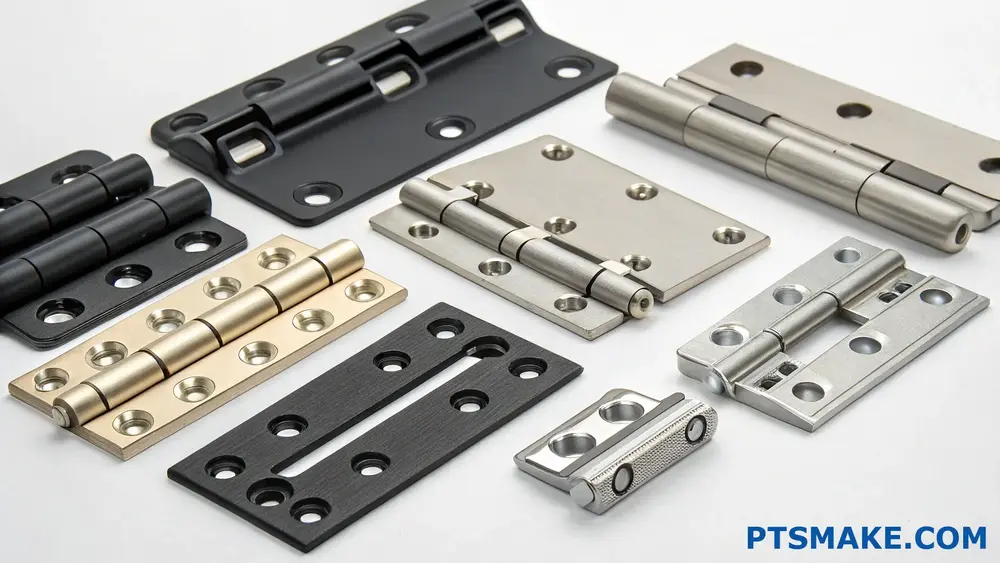
Understanding Your Application Requirements
When selecting custom hinges, the first and most crucial step is thoroughly understanding your application. In my experience working with clients at PTSMAKE, I’ve found that many engineers focus too heavily on basic specifications while overlooking critical application-specific requirements.
Load and Movement Analysis
Start by analyzing the exact type of movement your application requires. Is it a simple 180-degree swing, or does it need multiple axes of rotation? What about the frequency of operation—will the hinge be used occasionally or thousands of times daily?
For load considerations, determine:
- Maximum weight the hinge will support
- Direction of load (vertical, horizontal, or angular)
- Dynamic loads vs. static loads
- Impact or shock loads the hinge might experience
One client came to us after three failed attempts with standard hinges for a specialized medical device. The application required precise positioning with minimal play while supporting variable loads. By conducting a detailed load analysis, we designed a custom solution with reinforced pivot points and specialized bearing surfaces that has performed flawlessly for years.
Space and Dimensional Constraints
Custom hinges shine when dealing with tight spaces or unusual mounting arrangements. Unlike standard hinges that force you to design around their dimensions, custom options can be tailored to fit your exact spatial requirements.
Consider these dimensional factors:
- Available mounting space
- Clearance requirements when open and closed
- Knuckle size and quantity needed for strength
- Pin diameter requirements
Operational Environment
The environment where your hinge will operate dramatically affects material selection and design requirements. I’ve seen countless premature failures when this factor is overlooked.
Environmental considerations include:
- Temperature range (both high and low extremes)
- Exposure to moisture, salt spray, or humidity
- Chemical exposure (cleaning agents, oils, acids, etc.)
- UV exposure and weathering
- Dust, sand, or particulate exposure
For example, a standard stainless steel hinge might seem sufficient for an outdoor application, but without specific passivation4 treatment and the right grade selection, it could still corrode prematurely in marine environments.
Material Selection for Custom Hinges
Material selection is perhaps the most significant advantage custom hinges offer over standard options. While standard hinges typically come in a limited range of materials (usually brass, steel, or stainless steel), custom hinges can be manufactured from virtually any machinable material.
Metals and Alloys
Each metal brings unique properties to hinge applications:
| Material | Strengths | Limitations | Best Applications |
|---|---|---|---|
| 304 Stainless Steel | Good corrosion resistance, strong, cost-effective | Not suitable for marine environments | Indoor equipment, food service applications |
| 316 Stainless Steel | Superior corrosion resistance, excellent for marine environments | Higher cost than 304 | Marine equipment, outdoor installations, chemical processing |
| Aluminum | Lightweight, good strength-to-weight ratio | Less wear resistant than steel | Aerospace, portable equipment |
| Brass | Self-lubricating, decorative, antimicrobial | Lower strength than steel | Architectural applications, decorative hardware |
| Titanium | Exceptional strength-to-weight ratio, biocompatible | Very expensive, difficult to machine | Medical devices, aerospace, high-performance applications |
At PTSMAKE, we’ve developed expertise in CNC machining these various metals for custom hinges, allowing us to optimize material selection based on exact application requirements rather than settling for what’s available off-the-shelf.
Engineered Plastics
For applications requiring electrical insulation, chemical resistance, or weight reduction, engineered plastics offer excellent alternatives to metals:
| Plastic Material | Key Properties | Ideal Applications |
|---|---|---|
| Acetal (POM) | High stiffness, low friction, good fatigue resistance | Precision mechanisms, food equipment |
| PEEK | Extreme temperature resistance, excellent chemical resistance | Harsh chemical environments, high-temp applications |
| PTFE-filled nylon | Self-lubricating, good wear resistance | Applications requiring minimal maintenance |
| Fiberglass-reinforced composites | High strength, lightweight, non-conductive | Electrical enclosures, corrosive environments |
One manufacturing client needed hinges for electrical enclosures in a highly corrosive paper mill environment. Standard metal hinges failed within months due to the harsh chemical environment. We developed custom glass-filled polyamide hinges that have lasted years without degradation.
Specialized Hinge Designs for Specific Functions
Standard hinges typically serve basic opening and closing functions, but custom hinges can incorporate specialized features to solve complex design challenges.
Self-Closing and Controlled-Motion Hinges
When your application requires controlled movement or specific positioning capabilities, custom hinges offer solutions that standard products cannot:
- Spring-loaded designs – Create constant closure force for applications needing self-closing functionality
- Friction hinges – Maintain position at any angle, ideal for display screens and adjustable components
- Detent hinges – Provide tactile feedback and stable positioning at predetermined angles
- Damped hinges – Control closing speed to prevent slamming
These specialized mechanisms can be precisely calibrated to your requirements—something impossible with off-the-shelf options.
Concealed and Invisible Hinges
For applications where aesthetics matter, custom concealed hinges provide clean lines and hidden mechanical components. We’ve designed numerous custom invisible hinge solutions that completely disappear when closed, maintaining the visual integrity of high-end products.
Key considerations for concealed hinges include:
- Material strength requirements (often need stronger materials due to smaller size)
- Installation method and adjustment capabilities
- Clearance requirements for full motion
Multi-Axis and Complex Motion Hinges
Standard hinges typically only rotate around a single axis. Custom hinges can incorporate multiple pivot points to create complex motion paths:
- Double-action hinges – Allow movement in two directions from closed position
- Multi-link hinges – Create specialized motion paths for unique applications
- Compound hinges – Combine different movement types in a single mechanism
At PTSMAKE, we developed a custom three-axis hinge for a specialized robotic medical device that needed to fold compactly for storage while providing precise positioning during operation—something impossible to achieve with standard components.
Durability and Lifecycle Considerations
When selecting custom hinges, understanding the expected lifecycle requirements ensures you choose appropriate materials and design features.
Wear Resistance and Longevity
Custom hinges can be designed with specific wear-resistant features that standard hinges lack:
- Specialized bearing surfaces (bronze bushings, PTFE liners, etc.)
- Hardened wear surfaces through heat treatment or case hardening
- Replaceable wear components for extended service life
- Integrated lubrication systems or self-lubricating materials
I’ve worked with manufacturers who previously replaced standard hinges every few months in high-cycle applications. By designing custom hinges with hardened pins and replaceable bushings, we extended service intervals to years rather than months.
Maintenance Requirements
Custom hinges can be designed to either minimize or simplify maintenance:
- Sealed designs that prevent contamination
- Lubrication ports for maintenance without disassembly
- Modular designs allowing partial replacement of worn components
These features not only extend service life but also reduce downtime and maintenance costs.
Integration with Surrounding Components
One often overlooked advantage of custom hinges is their ability to integrate seamlessly with surrounding components, eliminating the need for adapters or modifications.
Mounting Configurations
Custom hinges can incorporate mounting features specifically designed for your application:
- Integrated mounting flanges matching your exact bolt pattern
- Specialized mounting methods (welding tabs, T-slot compatibility, etc.)
- Countersunk or specialized fastener interfaces
For a client manufacturing specialized enclosures, we designed custom hinges with mounting flanges that perfectly matched their existing automated assembly process, eliminating manual alignment steps and reducing assembly time by 40%.
Wire and Cable Management
For electronic applications, custom hinges can integrate wire management features:
- Hollow pin designs allowing cables to pass through the pivot point
- Cable channels and strain relief features
- Integrated wire protection to prevent pinching
Aesthetic Integration
When appearance matters, custom hinges can be designed to complement your product’s aesthetics:
- Custom finishes matching your product (specialized anodizing, powder coating, etc.)
- Radius edges and design elements that match your product’s design language
- Brand-specific design details or logos
Cost Considerations: Beyond the Price Tag
While custom hinges typically have higher upfront costs than standard options, the total cost of ownership often favors custom solutions for specialized applications.
Initial vs. Lifetime Costs
When evaluating costs, consider:
- Installation costs (often lower with application-specific custom hinges)
- Maintenance costs over the product lifecycle
- Replacement frequency compared to standard hinges
- Warranty claims and customer satisfaction impacts
One manufacturer I worked with initially balked at the price of custom hinges that cost three times more than their standard hinges. However, after calculating the reduced installation time, eliminated field failures, and extended service life, they discovered the custom solution reduced total costs by over 60% across the product lifecycle.
Production Volume Considerations
The economics of custom hinges vary significantly based on production volume:
| Production Volume | Custom Hinge Considerations |
|---|---|
| Low Volume (Prototype/Small Batch) | CNC machined custom hinges offer low setup costs but higher per-unit costs, ideal for testing or |
How Does CNC Machining Improve Custom Hinge Precision?
Have you ever struggled with hinges that don’t align properly or wear out too quickly? Or watched a beautifully designed door sag because of imprecise hinge tolerances? These frustrating issues can compromise both function and aesthetics in your projects.
CNC machining dramatically improves custom hinge precision through computer-controlled consistency, micron-level tolerances, and advanced material processing capabilities. This technology eliminates human error while enabling complex geometries and superior surface finishes that traditional manufacturing methods simply cannot achieve.
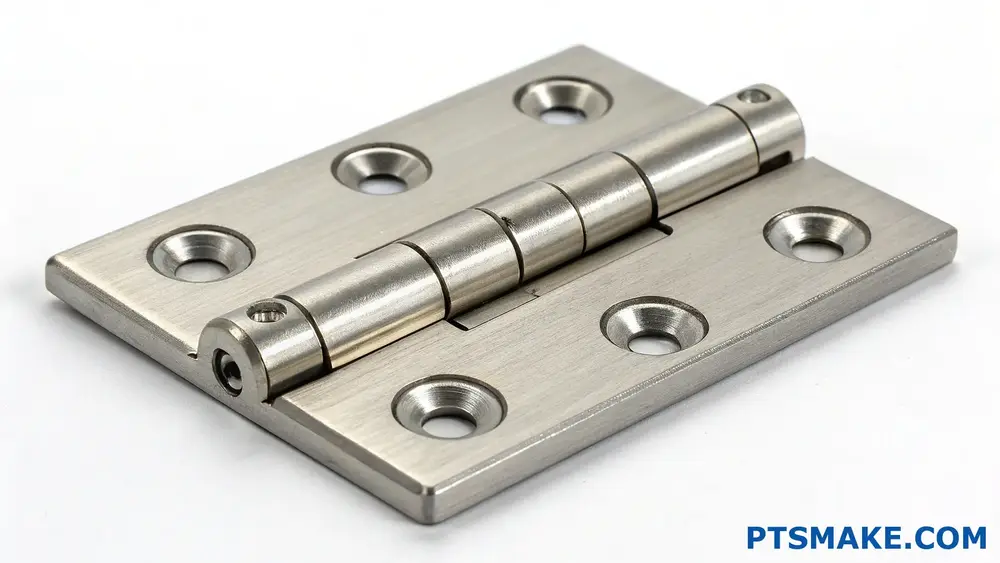
The Technological Edge of CNC Machining for Hinges
When it comes to creating high-performance custom hinges, precision is non-negotiable. In my experience working with engineering teams across various industries, I’ve found that CNC machining provides several distinct advantages for hinge manufacturing that traditional methods simply cannot match.
Micron-Level Accuracy and Consistency
CNC machining excels at delivering consistent results across production runs – something crucial for hinges that must function flawlessly for thousands of cycles. Modern CNC machines can achieve tolerances as tight as ±0.005mm (0.0002 inches), which is essential when creating kinematic constraints5 in hinge mechanisms.
The impact of this precision becomes evident when examining the performance metrics of CNC-machined hinges:
| Performance Factor | Conventional Methods | CNC Machining |
|---|---|---|
| Dimensional Tolerance | ±0.05mm – ±0.1mm | ±0.005mm – ±0.02mm |
| Surface Finish | 3.2-6.3 μm Ra | 0.8-1.6 μm Ra |
| Cycle Consistency | Variable | >99.8% |
| Operational Lifespan | 5,000-10,000 cycles | 25,000-100,000+ cycles |
This level of precision directly translates to smoother operation, reduced wear, and longer hinge life. At PTSMAKE, our aerospace clients particularly value this consistency when ordering custom hinges for critical applications where failure isn’t an option.
Material Versatility and Optimization
CNC machining shines in its ability to work with virtually any machinable material, allowing engineers to select the optimal material for specific hinge applications:
- Aluminum Alloys – Excellent for lightweight applications requiring good corrosion resistance
- Stainless Steel – Ideal for food-grade or medical hinges requiring strength and cleanliness
- Brass – Often selected for decorative hinges with natural antimicrobial properties
- Engineering Plastics – Perfect for non-conductive or chemically resistant applications
The precision of CNC machining enables us to take full advantage of these materials’ properties. For example, when machining titanium hinges for medical devices, we can precisely control cutting parameters to prevent work hardening while maintaining the material’s biocompatibility and strength.
Complex Geometries and Integrated Features
Traditional hinge manufacturing often requires multiple processes and assembly steps. CNC machining can integrate complex features in a single setup, improving both precision and efficiency:
Integrated Pin Systems
Modern 5-axis CNC machines can create intricate pin housings and retention systems directly into the hinge body. This integration eliminates assembly misalignment issues and increases structural integrity.
Custom Stop Mechanisms
Precision machining allows for the creation of built-in stop mechanisms with exact angular limitations. Rather than adding separate components, these features can be machined directly into the hinge body, ensuring perfect alignment and function.
Weight Reduction Features
For applications where weight matters (aerospace, high-performance automotive), CNC machining can create internal pocketing and structural optimization that would be impossible with conventional manufacturing methods.
Impact on Hinge Performance Metrics
The precision advantages of CNC machining directly translate to measurable performance improvements in custom hinges:
Reduced Friction and Wear
Surface quality plays a critical role in hinge performance. CNC machining typically produces surface finishes between 0.8-1.6 μm Ra (roughness average), significantly smoother than conventional methods. This directly affects:
- Operational friction – Smoother surfaces reduce resistance during operation
- Wear patterns – Even microscopic imperfections can become wear initiation points
- Lubrication effectiveness – Precisely controlled surface textures can optimize lubricant retention
When we produce custom hinges for robotic applications, this reduced friction translates to lower power consumption and heat generation during operation – critical factors in battery-powered systems.
Enhanced Load Distribution
The precision of CNC machining ensures perfectly aligned contact surfaces within hinge assemblies. This alignment optimizes load distribution across the entire bearing surface rather than concentrating stress at high points.
In practical terms, this means:
- Higher load capacity without deformation
- More consistent operational feel throughout the hinge’s service life
- Reduced risk of catastrophic failure under peak loads
For one automotive client, switching to CNC-machined custom hinges for a hood application increased the load capacity by 35% while simultaneously reducing the required maintenance frequency.
Improved Motion Control
CNC precision allows for exact control of the hinge’s rotational dynamics:
- Controlled clearances – Gaps as small as 0.02mm can be consistently maintained
- Optimized pivot geometries – Custom pivot profiles for specific motion characteristics
- Integrated damping features – Precisely machined features can control opening/closing speed
These capabilities have proven particularly valuable in consumer electronics applications, where the "feel" of a hinge’s movement significantly impacts user perception of product quality.
Case Study: Precision Transformation
A recent project at PTSMAKE demonstrates the transformative impact of CNC machining on hinge precision. A medical equipment manufacturer was experiencing inconsistent performance with traditionally manufactured hinges in their imaging equipment. The issues included:
- Inconsistent opening force
- Gradual misalignment during use
- Premature wear requiring frequent replacement
By transitioning to CNC-machined custom hinges, we achieved:
- Dimensional consistency within ±0.01mm across all critical interfaces
- Integrated self-centering features machined directly into the hinge components
- Surface finishes below 1.2 μm Ra at all bearing surfaces
The results were significant:
| Performance Metric | Before CNC Implementation | After CNC Implementation |
|---|---|---|
| Service Life | 8-12 months | >36 months |
| Alignment Drift | Up to 2.5mm | <0.3mm |
| Opening Force Variation | ±15% | ±3% |
| Warranty Claims | 4.2% | 0.3% |
This transformation demonstrates how CNC machining doesn’t just marginally improve hinge performance – it can fundamentally change the reliability profile of precision components.
Material-Specific Precision Advantages
Different hinge applications require different materials, and CNC machining offers unique precision advantages for each:
Stainless Steel Hinges
For stainless steel hinges used in marine or outdoor applications, CNC machining enables:
- Precise thread cutting – Critical for corrosion-resistant fastener integration
- Controlled hardness zones – Selective machining parameters can maintain ductility where needed
- Optimal grain orientation – Strategic machining approaches can work with material grain for maximum strength
Aluminum Alloy Hinges
Aluminum presents unique challenges that CNC machining addresses effectively:
- Heat dissipation features – Precision cooling fins or channels can be integrated
- Anodizing preparation – Surface preparation optimized for subsequent finishing
- Thickness optimization – Varied wall thicknesses based on stress analysis
Engineering Plastic Hinges
For non-metallic applications, CNC machining offers advantages that injection molding cannot match:
- Zero internal stress – Unlike molded parts, machined plastic hinges contain no internal stresses
- Selective reinforcement – Thicker sections only where required by load analysis
- Multi-material integration – Precision pockets for inserts or reinforcements
Implementation Considerations
While CNC machining offers tremendous precision advantages for custom hinges, implementation requires careful planning:
Design Optimization for CNC
To maximize the benefits of CNC precision, hinge designs should be optimized with several factors in mind:
- Tool accessibility – Ensuring all features can be reached by cutting tools
- Datum consistency – Establishing proper reference points for multi-setup operations
- Feature sequencing – Planning the order of operations for maximum precision
At PTSMAKE, our engineering team works closely with clients to refine designs for optimal CNC manufacturing, often identifying opportunities for improved performance through minor design adjustments.
Quality Verification Protocols
The precision capabilities of CNC machining must be paired with equally precise inspection methods:
- In-process measurement – Dimensional verification during production
- Surface quality assessment – Quantitative analysis of finished surfaces
- Functional testing – Operational verification under simulated conditions
Our standard protocol for precision hinges includes 100% inspection of critical dimensions and statistical process control to ensure consistent quality across production runs.
Cost-Benefit Analysis
While CNC machining offers superior precision, it’s important to conduct a thorough cost-benefit analysis:
- Lifecycle cost comparison – Accounting for reduced replacement and maintenance
- Volume considerations – Determining the crossover point where other methods become more economical
- Performance requirements evaluation – Matching precision capabilities to actual application needs
In many cases, the initial higher cost of CNC-machined hinges is offset by their extended service life and improved performance. For critical applications, the precision advantage is simply non-negotiable regardless of cost considerations.
Future Trends in CNC Hinge Manufacturing
The precision capabilities of CNC machining for custom hinges continue to evolve, with several emerging trends:
Hybrid manufacturing – Combining CNC
What Factors Affect The Lead Time For Custom Hinge Production?
Have you ever placed an order for custom hinges only to be surprised by unexpected delays? Or found yourself struggling to explain timeline changes to stakeholders when your production schedule shifts unexpectedly? These timing challenges can derail even the most carefully planned projects.
The lead time for custom hinge production is typically affected by design complexity, material availability, production volume, manufacturing processes, quality requirements, and supplier capabilities. These factors collectively determine how quickly your custom hinges can move from concept to delivery.
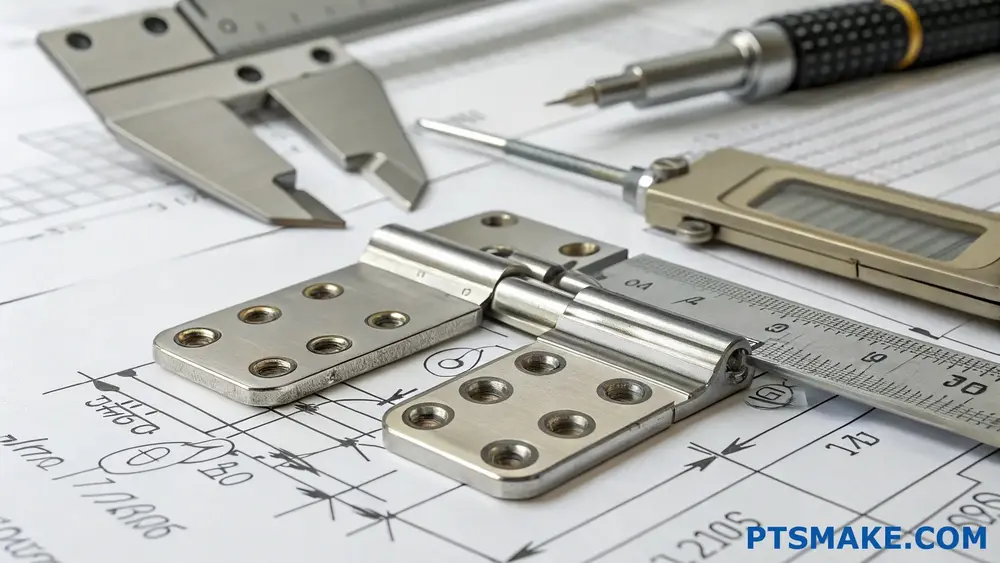
Understanding Production Lead Time Variables
When it comes to custom hinge manufacturing, lead time can vary significantly depending on numerous factors. In my experience working with clients at PTSMAKE, I’ve observed that understanding these variables helps project managers and engineers set realistic expectations and plan more effectively.
Design Complexity and Engineering Requirements
The complexity of your hinge design dramatically impacts lead time. Simple butt hinges with standard configurations might be manufactured relatively quickly, while complex kinematic hinge mechanisms6 with multiple pivot points require additional engineering time and precision manufacturing.
Design complexity affects lead time in several ways:
Engineering Review Time: Complex designs require thorough engineering reviews to ensure manufacturability. This may include design for manufacturing (DFM) analysis and potential design modifications.
Tooling Requirements: Custom hinges often need specialized tooling or fixtures, which must be designed and manufactured before production begins.
Tolerance Specifications: Tighter tolerances require more precise machining and additional quality checks, extending the manufacturing timeline.
Prototyping Needs: Complex designs typically benefit from prototyping phases, which add time but reduce the risk of issues during full production.
For example, a basic stainless steel butt hinge might take 2-3 weeks to produce, while a custom multi-axis hinge with specialized coatings could require 6-8 weeks or more.
Material Selection and Availability
Material choice significantly impacts lead time for custom hinges. Some considerations include:
Common Hinge Materials and Their Lead Time Impact
| Material Type | Typical Availability | Lead Time Impact | Special Considerations |
|---|---|---|---|
| Stainless Steel | High | Minimal | Standard grades readily available |
| Brass | Moderate | Low-Medium | May require specific alloy sourcing |
| Aluminum | High | Minimal | Common in stock at most suppliers |
| Specialty Alloys | Low | High | Often requires special ordering |
| Engineered Polymers | Variable | Medium-High | Material properties verification needed |
| Titanium | Low | High | Limited supplier options, premium pricing |
Material availability fluctuates based on market conditions and global supply chain dynamics. When working with clients at PTSMAKE, I always recommend considering material availability early in the design process. In some cases, designing with readily available materials can significantly reduce lead times compared to exotic options.
Production Quantity and Batch Size
Order quantity plays a crucial role in determining lead time for custom hinges:
Small Batch Production: Orders of 10-100 units often have shorter absolute lead times but higher per-unit costs and relatively longer per-unit production times.
Medium Batch Production: Orders of 100-1,000 units typically achieve better economies of scale but require more extensive production planning.
Large Batch Production: Orders exceeding 1,000 units usually have the longest overall lead times but benefit from optimized manufacturing workflows and lower per-unit costs.
I’ve found that many clients underestimate the impact of quantity on scheduling. For instance, a small prototype run might be completed in 2-3 weeks, while scaling to production quantities of several thousand units could extend lead time to 6-8 weeks due to material procurement, machine scheduling, and quality control requirements.
Manufacturing Processes and Technologies
The specific manufacturing methods used to produce custom hinges significantly influence lead time. Each process has unique time requirements and constraints.
CNC Machining vs. Stamping vs. Die Casting
Different manufacturing methods offer various tradeoffs between precision, volume capability, and lead time:
CNC Machining:
- Offers high precision and flexibility
- Ideal for low to medium volumes
- Typical setup time: 1-2 weeks
- Production rate: Slower for complex geometries
- Best for: Prototypes and precision components
Metal Stamping:
- Requires tooling investment (2-4 weeks for tool creation)
- High production speeds once tooling is complete
- Economical for higher volumes
- Limited design complexity compared to CNC
- Best for: High-volume, relatively simple hinge designs
Die Casting:
- Longer initial tooling lead time (4-6 weeks)
- Excellent for complex geometries in high volumes
- Very fast production once tools are ready
- Best for: Complex designs needed in large quantities
At PTSMAKE, we evaluate each project to determine the optimal manufacturing approach based on design requirements, volume needs, and timeline constraints. Sometimes hybrid approaches work best—using CNC machining for initial production while developing stamping tools for long-term manufacturing.
Secondary Processes and Finishing Requirements
Custom hinges often require additional processing beyond the primary forming operations:
- Heat Treatment: Adds 3-7 days to strengthen certain materials
- Surface Finishing: Processes like anodizing (aluminum) or plating add 5-10 days
- Passivation: Required for stainless steel, adds 2-4 days
- Assembly: Multi-component hinges require additional assembly time
- Testing: Load testing or cycle testing for critical applications adds 1-5 days
These secondary operations are often overlooked in initial timeline estimates but can significantly impact final delivery dates. For example, a seemingly simple stainless steel hinge requiring passivation, specialized lubricant application, and functional testing could have 7-10 days of additional lead time beyond the basic manufacturing process.
Quality Control and Testing Requirements
The level of quality assurance required for your custom hinges will directly impact lead time. More stringent quality requirements necessitate additional inspection points and possibly testing procedures.
Inspection Protocols and Their Timeline Impact
Different quality control regimes add varying amounts of time to the production process:
- Standard Visual Inspection: Minimal impact (hours)
- Dimensional Verification (sampling): 1-2 days
- 100% Dimensional Inspection: 3-7 days depending on volume
- Material Certification Requirements: Can add 1-2 weeks if specialized testing is needed
- Functional Testing: Load testing, cycle testing, environmental testing can add 1-2 weeks
In regulated industries like aerospace or medical devices, documentation and traceability requirements add additional verification steps. I’ve worked with medical device manufacturers whose hinges required complete traceability from raw material to finished product, adding nearly two weeks to the production timeline compared to similar commercial projects.
Supplier Capabilities and Capacity
Not all manufacturers have the same capabilities, equipment, or capacity. These differences significantly impact lead times for custom hinges.
Production Capacity and Scheduling
Supplier production capacity directly affects how quickly your order can be processed:
- Equipment Availability: High-demand equipment may have scheduling backlogs
- Workforce Specialization: Complex projects require skilled technicians who may be limited resources
- Production Prioritization: Some suppliers prioritize larger orders or long-term customers
- Seasonal Factors: Many manufacturers experience seasonal fluctuations in capacity
At PTSMAKE, we maintain flexible manufacturing capacity specifically to accommodate urgent custom projects. However, I’ve observed that across the industry, lead times can increase by 30-50% during peak manufacturing seasons (typically pre-holiday periods and fiscal year-end for many industries).
Geographic and Logistical Considerations
The physical location of your supplier introduces several lead time variables:
- Domestic vs. Offshore Production: Offshore manufacturing may offer cost advantages but typically adds 2-4 weeks in shipping time alone
- Customs Clearance: International shipping requires customs processing, adding unpredictable delays
- Communication Barriers: Time zone differences and language barriers can extend engineering review cycles
- Shipping Methods: Air freight vs. sea freight decisions dramatically impact delivery timeframes
Working with a supplier that offers domestic manufacturing capabilities for time-sensitive projects while maintaining offshore options for cost-sensitive larger production runs provides the best flexibility.
Strategies for Minimizing Lead Times
Based on my experience working with hundreds of custom hinge projects, I’ve developed several practical strategies to help clients minimize lead times.
Design Optimization for Manufacturing Efficiency
Implementing design for manufacturing (DFM) principles early in development can significantly reduce lead times:
- Standardize When Possible: Using standard dimensions and features where they don’t compromise function
- Design for Available Equipment: Creating designs that leverage the manufacturer’s existing machinery
- Material Selection Strategy: Choosing readily available materials when possible
- Tolerance Specification: Only specifying tight tolerances where functionally necessary
- Consolidate Parts: Reducing assembly requirements by combining components where feasible
These design optimizations can reduce manufacturing lead time by 15-30% in many cases. At PTSMAKE, our engineering team regularly conducts design reviews to identify such opportunities.
Effective Communication and Documentation
Clear communication significantly reduces delays caused by misunderstandings:
- Comprehensive Technical Drawings: Including all critical dimensions and specifications
- Material Requirements: Clearly specifying material grades and alternatives
- Quality Expectations: Documenting inspection requirements upfront
- Timeline Milestones: Establishing clear production milestones and check-in points
I’ve seen projects delayed by weeks simply because material
Quality Testing and Certification in Custom Hinge Manufacturing?
Have you ever received custom hinges that failed during installation or shortly after deployment? Or spent countless hours troubleshooting issues caused by substandard components? Quality testing isn’t just a final checkbox—it’s the difference between project success and costly failures.
Quality testing and certification in custom hinge manufacturing involves systematic inspection protocols, performance testing under real-world conditions, and adherence to industry standards. Effective testing identifies potential failures before deployment, ensuring hinges meet specific application requirements and perform reliably throughout their intended lifecycle.
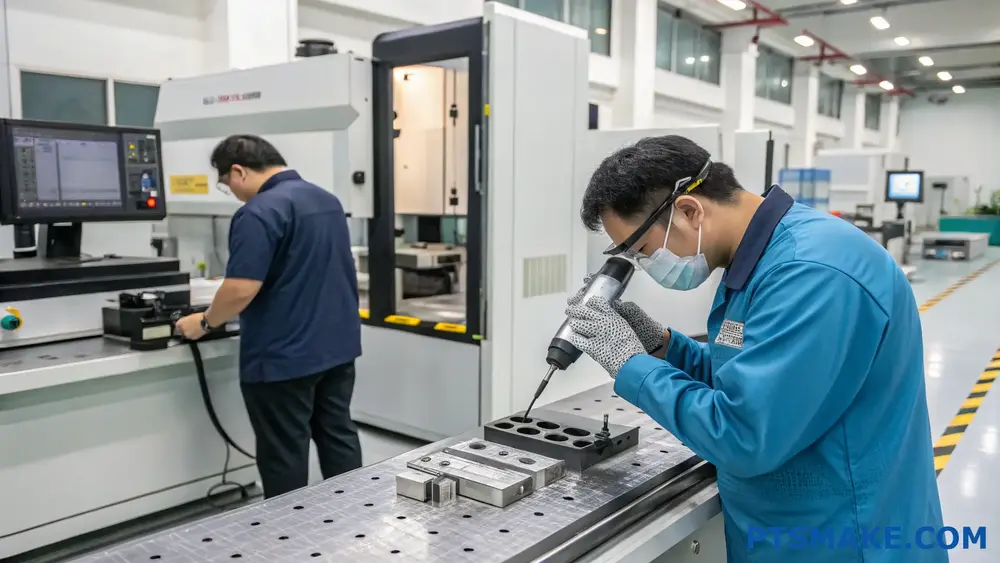
The Critical Role of Quality Testing in Hinge Manufacturing
Quality testing is not merely an additional step in the manufacturing process—it’s the foundation of reliable custom hinge production. During my career at PTSMAKE, I’ve observed that the most successful projects always incorporate comprehensive testing protocols. These protocols serve as the guardrail that prevents defective products from reaching customers.
Testing begins with the raw materials and continues throughout the production process. When manufacturers verify the quality of materials before production, they effectively prevent many potential issues from occurring later. For example, testing the chemical composition and mechanical properties of metals can reveal whether they’ll withstand the stresses of specific applications.
Destructive vs. Non-Destructive Testing Methods
There are two primary approaches to quality testing in custom hinge manufacturing:
Destructive Testing: This involves testing hinges to the point of failure to determine their ultimate strength and durability. While this means sacrificing some samples, it provides crucial data about performance limits.
Non-Destructive Testing (NDT): These methods evaluate properties without damaging the hinges, allowing for 100% inspection in production environments.
The choice between these methods depends on several factors including production volume, cost constraints, and application requirements. In practice, most manufacturers use a combination of both approaches to achieve optimal quality control.
Common Non-Destructive Testing Techniques for Hinges
| Testing Method | What It Detects | Best For |
|---|---|---|
| Visual Inspection | Surface defects, finish issues | Quick quality checks |
| Dimensional Verification | Size and tolerance deviations | Ensuring proper fit |
| X-ray Testing | Internal structural defects | Complex hinge assemblies |
| Ultrasonic Testing | Hidden cracks or voids | Critical safety applications |
| Magnetic Particle Inspection | Surface/near-surface cracks | Ferromagnetic materials |
| Dye Penetrant Inspection | Surface cracks | Non-porous materials |
When implementing these tests, it’s important to establish clear acceptance criteria beforehand. This ensures consistent evaluation regardless of who performs the inspection. At PTSMAKE, we’ve developed standardized testing protocols that align with both international standards and customer-specific requirements.
Performance Testing Parameters for Custom Hinges
Beyond basic inspection, hinges must undergo performance testing to verify they’ll function as expected in actual applications. The specific tests depend on the hinge type and intended use, but typically include:
Mechanical Load Testing
Load testing simulates the forces hinges will encounter during use. This includes:
- Static Load Tests: Measuring a hinge’s ability to support weight without deformation
- Dynamic Load Tests: Evaluating performance under moving loads
- Overload Tests: Determining breaking points and safety margins
For critical applications, I recommend testing hinges at 150-200% of their expected maximum load to ensure adequate safety margins. This approach has helped us deliver exceptionally reliable components for aerospace and medical applications.
Cycle Testing for Durability Assessment
Cycle testing involves repeatedly opening and closing hinges to simulate years of use. This test identifies:
- Wear patterns
- Potential points of failure
- Lubrication requirements
- Expected service life
The number of cycles should match or exceed the expected lifetime usage. For example, a door hinge might be tested for 100,000+ cycles, while an electronics enclosure hinge might require fewer cycles but higher precision throughout its lifespan.
Recently, we manufactured custom hinges for a medical equipment manufacturer that required validation for 500,000 cycles without failure—five times the industry standard. By carefully selecting materials and optimizing the design through finite element analysis7, we delivered components that exceeded this demanding requirement.
Environmental Testing
Environmental testing ensures hinges perform reliably under various conditions they’ll face during use:
- Temperature Cycling: Verifying performance across temperature ranges
- Humidity Testing: Assessing resistance to moisture damage
- Salt Spray Testing: Evaluating corrosion resistance
- UV Exposure: Testing degradation from sunlight (particularly important for outdoor applications)
- Chemical Resistance: Ensuring compatibility with cleaning agents or environmental exposures
For outdoor applications, I’ve found that combining salt spray testing with cycle testing provides the most realistic assessment of long-term performance. This combination has proven especially valuable for marine and outdoor infrastructure projects.
Industry Standards and Certification Requirements
Adhering to industry standards provides a framework for quality and helps ensure custom hinges meet minimum performance requirements. The relevant standards vary by industry:
Key Industry Standards for Hinge Manufacturing
- ANSI/BHMA A156 Series: Standards for architectural hardware including hinges
- MIL-SPEC: Military specifications for defense applications
- ISO 9001: Quality management systems requirements
- ASTM E2068: Standard test method for determining operating and breakaway forces of hinges
- CE Marking: Required for products sold in European markets
For international business, understanding regional certification requirements is essential. Different markets may have unique standards that must be met before products can be legally sold.
Material-Specific Certifications
The materials used in hinge manufacturing often require their own certifications:
- RoHS Compliance: Restricts hazardous substances in electronic equipment
- REACH Compliance: Regulates chemical substances in the EU
- FDA Compliance: Required for hinges used in food service or medical applications
- Fire Resistance Ratings: Critical for building hardware applications
Maintaining detailed material certifications and traceability throughout the supply chain is crucial. At PTSMAKE, we maintain comprehensive material documentation for all components, allowing us to quickly address any regulatory inquiries.
Implementing Effective Quality Control Processes
Quality control isn’t just about testing final products—it’s a comprehensive approach that begins with design and continues through delivery.
Quality Control Plan Development
An effective quality control plan for custom hinges should include:
- Design Review: Verifying the design meets all specifications and standards
- Material Verification: Confirming materials meet required specifications
- In-Process Inspection: Checking critical dimensions and features during manufacturing
- Final Testing: Validating completed hinges against performance requirements
- Documentation: Maintaining records of all quality-related activities
For complex projects, I recommend developing a formal Quality Assurance Plan that defines responsibilities, testing methods, acceptance criteria, and documentation requirements.
Statistical Process Control in Hinge Manufacturing
Statistical Process Control (SPC) uses data analysis to monitor and control manufacturing processes. Implementing SPC for hinge production offers several benefits:
- Early detection of process drift before defects occur
- Reduced variation in critical dimensions
- Data-driven process improvements
- Decreased inspection costs through targeted sampling
By analyzing key process variables, manufacturers can identify potential issues before they affect product quality. For instance, monitoring tool wear patterns has allowed us to develop predictive maintenance schedules that minimize production disruptions.
Documentation and Traceability Systems
Comprehensive documentation is essential for quality management:
- Material Certificates: Documenting material properties and compliance
- Process Records: Tracking manufacturing parameters
- Inspection Results: Recording all quality checks and measurements
- Traceability Information: Linking finished products to raw materials and production batches
Modern manufacturers often implement digital tracking systems that follow components throughout the production process. These systems enable rapid response to any quality issues by identifying affected batches and associated production parameters.
Common Quality Issues and Preventive Measures
Understanding potential quality problems helps manufacturers implement preventive measures:
Surface Finish Defects
Surface finish problems can affect both aesthetics and function:
- Cause: Improper tool selection, incorrect machine parameters, or inadequate material preparation
- Prevention: Establish detailed finishing specifications, implement regular tool inspections, and develop standard operating procedures for surface preparation
- Testing: Use surface roughness testers and visual inspection standards
Dimensional Accuracy Issues
Dimensional problems can prevent proper assembly or function:
- Cause: Machine calibration errors, tool wear, or improper fixturing
- Prevention: Regular equipment maintenance, in-process measurement, and first-article inspection
- Testing: Coordinate measuring machines (CMMs), precision gauges, and optical measurement systems
Material Defects
Material problems can lead to premature failure:
- Cause: Supplier quality issues, improper material handling, or environmental contamination
- Prevention: Supplier qualification processes, material certification verification, and proper storage procedures
- Testing: Hardness testing, chemical analysis, and microstructure examination
Movement Performance Issues
Problems with smooth operation can make hinges unsuitable for their intended application:
- Cause: Improper lubrication, assembly errors, or design flaws
- Prevention: Design validation testing, assembly verification procedures, and proper lubrication specifications
- Testing: Torque testing, cycle testing, and functional verification
By implementing robust preventive measures, manufacturers can significantly reduce quality issues and the associated costs of rework or replacement.
The Economic Value of Comprehensive Testing
Investing in quality testing delivers substantial economic benefits:
Cost-Benefit Analysis of Quality Testing
While comprehensive testing adds cost to the manufacturing process, it typically provides a strong return on investment:
- Reduced Warranty Claims: Identifying problems before shipping minimizes expensive field failures
- Lower Rework Costs: Finding issues early reduces the
Can Custom Hinges Withstand High-Temperature Industrial Applications?
Have you ever installed what you thought was a perfect hinge solution, only to watch it fail when temperatures climbed? Or perhaps you’ve wasted valuable production time and resources replacing warped, melted, or brittle hinges that couldn’t handle your industrial environment? These frustrating scenarios play out in factories worldwide every day.
Yes, custom hinges can absolutely withstand high-temperature industrial applications when properly designed with specialized materials like high-grade stainless steel, Inconel, titanium alloys, or advanced ceramics, and engineered with appropriate thermal expansion considerations, coatings, and lubrication systems.
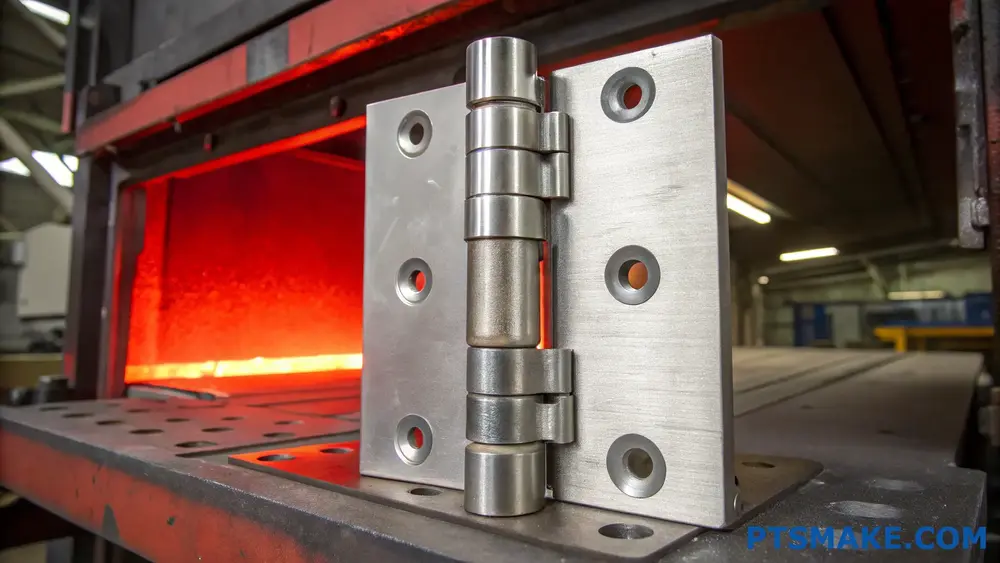
Understanding High-Temperature Challenges for Hinges
When we talk about "high-temperature" in industrial settings, we’re typically referring to environments that exceed 150°C (302°F), though this threshold varies by industry. In my years working with manufacturing clients, I’ve seen applications ranging from modest heat exposure in commercial kitchens to extreme temperatures in furnaces exceeding 1000°C (1832°F).
The challenges hinges face in these environments are multifaceted. Heat doesn’t just test a hinge’s melting point—it transforms material properties in ways that compromise structural integrity and functional performance. Let me break down the primary challenges:
Thermal Expansion and Contraction
Materials expand when heated and contract when cooled. This simple principle becomes complex when:
- Different materials expand at different rates (measured as Coefficient of Thermal Expansion or CTE)
- Components experience uneven heating
- Rapid temperature cycling occurs
In a multi-component assembly like a hinge, these differences create internal stresses that can warp components, loosen fasteners, or create binding that prevents smooth operation.
Material Degradation
High temperatures accelerate numerous degradation mechanisms:
- Oxidation (especially in metals)
- Creep (slow deformation under stress)
- Embrittlement
- Loss of tensile strength
- Breakdown of lubricants
For example, standard steel begins to lose significant strength above 400°C (752°F), while many plastics soften or deform well below 200°C (392°F).
Chemical Reactivity
Heat typically increases chemical reactivity, making materials more vulnerable to:
- Corrosion
- Galvanic reactions between dissimilar metals
- Reactions with process chemicals or fumes
In one automotive manufacturing project I consulted on, hinges near a heat-treating operation weren’t failing from the heat directly but from accelerated corrosion caused by the combination of high temperatures and specific process gases.
Material Solutions for High-Temperature Hinges
The foundation of any high-temperature hinge solution is selecting the right material. Here’s a comparative analysis of materials I frequently recommend:
Metals and Alloys
| Material | Temperature Range | Advantages | Limitations | Best Applications |
|---|---|---|---|---|
| Stainless Steel (316/316L) | Up to 870°C (1600°F) | Excellent corrosion resistance, good strength, widely available | Lower strength at extreme temperatures, susceptible to certain chemicals | Food processing, chemical plants, steam environments |
| Inconel Alloys | Up to 1200°C (2200°F) | Exceptional strength retention, oxidation resistance | Expensive, difficult to machine | Aerospace, furnace components, nuclear applications |
| Titanium Alloys | Up to 600°C (1100°F) | Excellent strength-to-weight ratio, corrosion resistance | Cost, limited availability of specialized grades | Lightweight applications with moderate heat exposure |
| Tungsten Alloys | Up to 1700°C (3100°F) | Extremely high heat resistance | Brittle, heavy, expensive | Furnace components, extreme temperature applications |
Ceramics and Advanced Materials
| Material | Temperature Range | Advantages | Limitations | Best Applications |
|---|---|---|---|---|
| Silicon Carbide | Up to 1600°C (2900°F) | Extreme hardness, wear resistance | Brittle, requires specialized manufacturing | Kiln furniture, high-wear high-heat applications |
| Silicon Nitride | Up to 1200°C (2200°F) | Low thermal expansion, good thermal shock resistance | Cost, complexity in forming complex shapes | Bearing components in hot environments |
| Advanced Composites | Varies by formulation | Customizable properties, potential weight savings | Often limited temperature resistance compared to metals and ceramics | Specialized applications requiring unique property combinations |
At PTSMAKE, I’ve found that most industrial applications benefit from custom-designed hinges using either high-grade stainless steel or, for more extreme conditions, nickel-based superalloys like Inconel. For clients with extreme temperature requirements, we often recommend a hybrid approach with ceramic bearing surfaces in metal structural components.
Design Strategies for Heat Resistance
Material selection is just the starting point. Successful high-temperature hinge applications require specialized design approaches:
Thermal Expansion Management
Uniform Material Selection: When possible, construct all components from the same material to ensure uniform expansion.
Expansion Joints: For larger assemblies, incorporate designed gaps or flexible elements that accommodate movement.
Floating Mounting Points: Design connection points that allow slight movement rather than rigid fixation.
I recently designed a custom hinge system for an industrial oven manufacturer where we incorporated small graphite inserts at key points to allow controlled movement during thermal cycling, extending hinge life by over 300%.
Thermal Isolation Techniques
Heat management often requires keeping heat where it belongs—away from critical components:
Heat Shields: Strategic placement of reflective barriers to redirect radiant heat.
Thermal Breaks: Incorporating low-conductivity materials at key junction points.
Active Cooling: For extreme applications, designing channels for air or liquid cooling.
Standoff Mounting: Creating distance between the heat source and the hinge mechanism.
Lubrication Considerations
Standard lubricants fail quickly in high-heat environments. Options I typically recommend include:
- Dry lubricants (graphite, molybdenum disulfide)
- Specialized high-temperature greases (often silicone or PTFE-based)
- Self-lubricating materials (oil-impregnated bronze, certain composites)
For a steel mill client, we developed a custom hinge with self-lubricating graphite-bronze bushings that eliminated the need for maintenance in a 600°C environment where standard lubrication would have carbonized within hours.
Surface Treatments and Coatings
Surface engineering provides another layer of protection for high-temperature hinges:
Oxidation-Resistant Coatings
- Chromium oxide layers
- Aluminum diffusion coatings
- Specialized ceramic coatings
These create protective barriers that prevent oxygen from reaching and reacting with the base metal at high temperatures.
Hard-Facing Treatments
For applications where wear combines with heat:
- Stellite overlays
- Tungsten carbide coatings
- Plasma-sprayed ceramic coatings
These protect against the accelerated wear that often occurs at high temperatures due to softened materials.
Case Hardening and Nitriding
These processes alter the surface composition of the material itself, creating a wear-resistant layer while maintaining core toughness. Various carburization8 processes are particularly effective for certain high-temperature applications, as they diffuse carbon into the metal surface to create a harder, more wear-resistant layer.
Custom Hinge Configurations for Extreme Environments
Beyond material and surface considerations, the physical design of the hinge itself can be optimized for high-temperature performance:
Knuckle and Pin Designs
The traditional knuckle-and-pin hinge design remains remarkably effective in high-temperature applications when properly engineered:
- Increased clearances to accommodate thermal expansion
- Oversized pins for strength retention at temperature
- Elongated knuckles for increased bearing surface and heat dissipation
Piano Hinge Adaptations
Continuous hinges distribute load and provide excellent stability in high-temperature applications:
- Segmented designs that allow for thermal expansion while maintaining continuous support
- Alternating materials to create expansion joints within the hinge line itself
Specialty Configurations
Some high-temperature applications benefit from less conventional approaches:
- Ball-bearing hinges with ceramic balls for reduced friction
- Composite hinges with strategic use of different materials in different zones
- Double-action configurations that reduce binding under thermal expansion
Real-World Application Examples
Let me share some specific applications where we’ve implemented custom high-temperature hinge solutions:
Industrial Furnace Doors
For a heat-treating furnace operating at 900°C (1650°F), we designed a custom hinge system featuring:
- Inconel 718 structural components
- Silicon nitride bearings
- Active water cooling channels in the mounting frame
- Molybdenum disulfide dry lubrication
This system has operated continuously for over five years without replacement—a significant improvement over the previous solution that required quarterly maintenance.
Glass Manufacturing Equipment
A glass producer needed hinges for access doors on annealing lehrs operating at 600°C (1100°F):
- Heat-resistant 310 stainless steel construction
- Oversized pin diameter with increased clearances
- Chromium oxide surface treatment
- Segmented design with expansion gaps
The solution eliminated binding issues that had plagued their previous design and reduced maintenance costs by approximately 40%.
Automotive Paint Curing Ovens
For a major automotive manufacturer, we developed hinges for paint curing oven doors operating at 200°C (392°F):
- 316 stainless steel construction
- PTFE-coated bearing surfaces
- Integrated heat shields
- Special thermal break mounts to prevent heat transfer to the building structure
This relatively moderate temperature application illustrates an important point: even at lower temperatures, specialized design can dramatically improve performance and lifespan.
Testing and Validation Methods
Developing reliable high-temperature hinges requires rigorous testing. When working with clients on custom solutions, I typically recommend:
- Thermal Cycling Tests: Repeatedly heating and cooling through the expected temperature range to identify issues with expansion/contraction
The link provides a comprehensive explanation and visual examples of flush-mounted installations. ↩
The link offers a detailed definition and examples of oxidation in chemistry. ↩
The link directs to an article that provides in-depth information about polyetheretherketone (PEEK), including its properties and applications. ↩
The link leads to a comprehensive explanation of passivation, a process that enhances the corrosion resistance of metals such as stainless steel by creating a protective oxide layer on its surface. ↩
The citation provides detailed insights into kinematic constraints crucial for precision in hinge operation. ↩
The citation explains intricate kinematic mechanisms, highlighting engineering challenges and manufacturing precision necessary. ↩
The citation elucidates finite element analysis, crucial for designing components meeting rigorous performance standards. ↩
The citation details carburization, essential for understanding enhanced wear resistance in high-temperature applications. ↩


